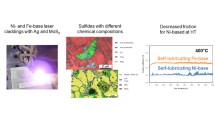Abstract
Good boundary lubrication is necessary during cold stamping of high-strength steel sheets to prevent die wear and seizure of the parts owing to the high contact pressure. This study is aimed to improve the seizure resistance in a 1-step combined process of deep drawing and ironing of ultra-high-strength steel cylindrical cups using a commercial lubricant containing SiO2 nanoparticles with an uncoated die. In this study, the extreme pressure performance of the lubricant containing 0.0, 0.5, 1.0, 1.5, 2.0 and 2.5 wt% of SiO2 was first evaluated using a deep drawing process under increased blank holding forces. The optimum concentration of SiO2 was determined, i.e. 2 wt%, based on successful drawing of cups having smooth surfaces under the highest holding force. Then, the ironing limits of the cups for the lubricants containing 0 and 2 wt% of SiO2 respectively were investigated with the 1-step combined process under increased ironing ratios. The experimental results showed that seizure was observed for the lubricant containing no nanoparticles at an ironing ratio of −16.7 %. However, no seizures were observed for ironing ratios up to 4.2 % using the lubricant containing 2 wt% of SiO2. The resistance to seizure of the cup was significantly increased, leading to the formation of cylindrical cups having smooth surfaces and uniform side wall thickness.
Similar content being viewed by others
References
Vižintin J (2004) Oil surface: additive reaction mechanisms. In: Totten GE, Liang H (eds) Surface modification and mechanisms. Marcel Dekker, New York, pp 243–298
Martin JM, Grossiord C, Le-Mogne T, Igarashi J (2000) Transfer films and friction under boundary lubrication. Wear 245(1–2):107–115. doi:10.1016/S0043-1648(00)00471-3
Willermet PA, Dailey DP, Carter RO, Schmitz PJ, Zhu W (1995) Mechanism of formation of antiwear films from Zinc Dialkyldithiophosphates. Tribol Int 28(3):177–187. doi:10.1016/0301-679X(95)98965-G
De Barros MI, Bouchet J, Raoult I, Le-Mogne T, Martin JM, Kasrai M, Yamada Y (2003) Friction reduction by metal sulfides in boundary lubrication studied by XPS and XANES analyses. Wear 254(9):863–870. doi:10.1016/S0043-1648(03)00237-0
Wagner S, Kleinert H, Zimmermann R (2002) Dry film lubricants for sheet metal forming. In: Proceedings of international conference of new developments in sheet forming. University of Stuttgart, Germany, pp 451–472
Kim H, Sung JH, Sivakumar R, Altan T (2007) Evaluation of stamping lubricants using the deep drawing test. Int J Mach Tools Manuf 47(14):2120–2132. doi:10.1016/j.ijmachtools.2007.04.014
Kim H, Altan T, Yan Q (2009) Evaluation of stamping lubricants in forming advanced high strength steels (AHSS) using deep drawing and ironing tests. J Mater Process Technol 209(8):4122–4133. doi:10.1016/j.jmatprotec.2008.10.007
Abe Y, Ohmi T, Mori K, Masuda T (2014) Improvement of formability in deep drawing of ultra-high strength steel sheets by coating of die. J Mater Process Technol 214(9):1838–1843. doi:10.1016/j.jmatprotec.2014.03.023
Hou Y, Zhang W, Yu Z, Li S (2009) Selection of tool materials and surface treatments for improved galling performance in sheet metal forming. Int J Adv Manuf Technol 43(9):1010–1017. doi:10.1007/s00170-008-1780-2
Tan CJ, Chong WT, Hassan MA (2013) End formation of a round tube into a square section having small corner radii. J Mater Process Technol 213(9):1465–1474. doi:10.1016/j.jmatprotec.2013.03.021
Tan CJ, Purbolaksono J, Chong WT (2015) Forming box-shaped ends in circular tubes. Int J Precis Eng Manuf 16(9):1975–1981. doi:10.1007/s12541-015-0257-0
Sarhan AAD, Sayuti M, Hamdi M (2012) Reduction of power and lubricant oil consumption in milling process using a new SiO2 nanolubrication system. Int J Adv Manuf Technol 63(5–8):505–512. doi:10.1007/s00170-012-3940-7
Sia SY, Bassyony EZ, Sarhan AAD (2014) Development of SiO2 nanolubrication system to be used in sliding bearings. Int J Adv Manuf Technol 71(5):1277–1284. doi:10.1007/s00170-013-5566-9
Ito K, Adachi K, Kato K (2006) Friction of Si3N4 ball / Si3N4 disk sliding in water with SiO2 nano-particles. Tribol Online 1(2):34–39. doi:10.2474/trol.1.34
Jiao D, Zheng S, Wang Y, Guan R, Cao B (2011) The tribology properties of alumina/silica composite nanoparticles as lubricant additives. Appl Surf Sci 257(13):5720–5725. doi:10.1016/j.apsusc.2011.01.084
Kobayashi K, Hironaka S, Suzue M, Ohta Y (2004) Lubricities of SiO2 particles coated with carbon. J Ceram Soc Jpn 112(4):210–213, in Japanese
Hosoe H, Hiratsuka K, Minami I, Hironaka S (1997) Lubricities of super fine SiO2 particle as a solid lubricant. J Ceram Soc Jpn 105(10):867–870, in Japanese
Yanagihara K, Tani Y, Murakami Y (2003) Proposal of new solid lubrication technology employing nm silica particles. Trans Jpn Soc Mech Eng C69(688):3384–3389, in Japanese
Tirosh J, Iddan D, Silviano M (1992) Hydrostatic ironing—analysis and experiments. J Manuf Sci Eng 114(2):237–243. doi:10.1115/1.2899777
Shirazi A, Abrinia K, Faraji G (2015) Hydroironing: a novel ironing method with a higher thickness reduction. Mater Manuf Process 30(1):99–103. doi:10.1080/10426914.2014.962659
Shirazi A, Abrinia K, Faraji G (2015) Analytical and experimental investigations on the novel hydro ironing process. Int J Adv Manuf Tech (In press) doi:10.1007/s00170-015-7535-y
Khodsetan M, Faraji G, Abrinia K (2015) A novel ironing process with extra high thickness reduction: constrained ironing. Mater Manuf Process 30(11):1324–1328. doi:10.1080/10426914.2015.1037898
Tan CJ, Abe Y, Daodon W, Takahashi N, Mori K, Purbolaksano J (2016) Increase in ironing limit of aluminium alloy cups with lubricants containing nanoparticles. J Mater Process Technol 229:804–813. doi:10.1016/j.jmatprotec.2015.10.032
Zhuang X, Sun X, Xiang H, Xia M, Zhao Z (2015) Compound deep drawing and extrusion process for the manufacture of geared drum. Int J Adv Manuf Tech (In press) doi:10.1007/s00170-015-7840-5
Author information
Authors and Affiliations
Corresponding author
Rights and permissions
About this article
Cite this article
Tan, C.J., Aslian, A., Abe, Y. et al. Improved seizure resistance of ultra-high-strength steel ironed cups with a lubricant containing SiO2 nanoparticles. Int J Adv Manuf Technol 87, 1705–1711 (2016). https://doi.org/10.1007/s00170-016-8588-2
Received:
Accepted:
Published:
Issue Date:
DOI: https://doi.org/10.1007/s00170-016-8588-2



